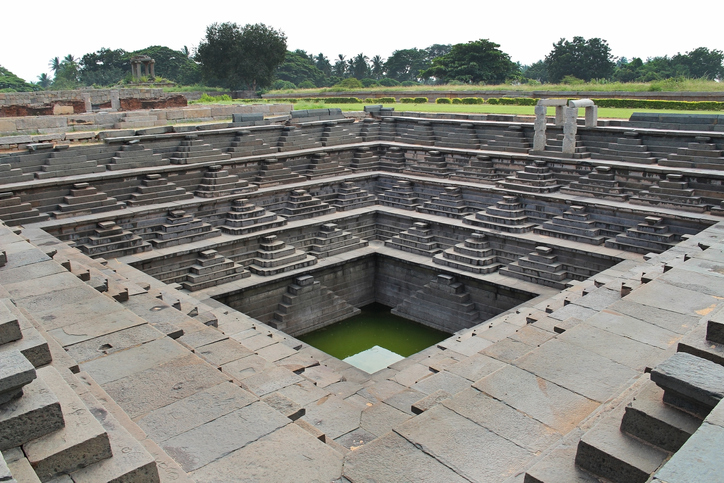Something to Know
A. Fill in the blanks.
1. Water helps in digestion of food in animals.
2. Animals living in water are called aquatic animals.
3. Animals, which can live both in water and on land, are called amphibious animals.
4. Water, trapped between underground rocks, is called ground water.
5. Water lily and lotus are aquatic plants.
B. Write True or False for the following statements.
1. Water is required for germination of seeds. True
2. Ground water can be drawn up by a hand pump. True
3. About 50% of water is present in seas and oceans. False
4. Octopus is an amphibious animal. False
5. River water is purified for drinking purpose. True
C. Tick (✔) the correct option.
1. About 97% of water is present in-
(a) seas and oceans (✔)
(c) ponds
(b) lakes
(d) glaciers
Answer – (a) seas and oceans (✔)
2. Plants absorb water from the soil with the help of-
(a) stem
(b) leaves
(c) branches
(d) roots (✔)
Answer – (d) roots (✔)
3. A rehat is used for-
(a) supplying water through taps.
(b) purifying river water.
(c) drawing out ground water for irrigation. (✔)
(d) absorbing water from the soil.
Answer – (c) drawing out ground water for irrigation. (✔)
4. An example of an amphibious animal is-
(a) fish
(b) frog (✔)
(c) hydrilla
(d) duckweed
Answer – (b) frog (✔)
D. Answer the following questions in brief.
1. Name any two water bodies that exist on the surface of earth.
Answer – Two water bodies that exist on the surface of earth are river and pond.
2. What are animals living in water known as? Write names of two such animals.
Answer – Animals living in water are known as aquatic animals. Examples- fish, whale
3. What are amphibious animals?
Answer – Animals which can live both in water and on land are called amphibious animals.
4. Write names of four aquatic plants.
Answer – Four aquatic plants- Water lily, lotus water hyacinth, hydrilla.
5. How do plants absorb water from the soil?
Answer – Plants absorb water from the soil with the help of their roots.
6. State two common methods of drawing out ground water.
Answer – Two common methods of drawing out groundwater are well and tubewell.
E. Answer the following questions.
1. Besides its domestic use, state three other uses of water.
Answer – Besides its domestic use that three other uses of water are:
Irrigation of field
Generation of electricity
Transportation.
2. How does water help in excretion of waste material from animal bodies?
Answer – Waste materials produced in the body get dissolved in water and are excreted in the form of urine.
3. List any four ways in which water is important for plants.
Answer – Four ways in which water is important for plants are:
Water helps to transport the nutrients dissolved in it from the soil to various parts of the plants.
Water helps in the process of photosynthesis.
Water is required for germination of seeds.
Water is also a habitat for many plants.
4. How can ground water be drawn out through tubewells?
Answer – In a tube well, a long pipe is inserted deep into the ground where it dips below the ground water level. Water is then drawn up by using a hand pump or an electric pump.
5. What is a stepwell?
Answer – Stepwell is a well having steps on all sides this enables people to go down to fetch water.
6. How is water supplied in cities?
Answer – The river water is usually purified by a series of processes that make it fit for drinking. This purified water is then sent to homes and offices through a network of pumps and pipes in cities.
Value Based Question
During the summer vacation, Kanika went to stay with her grandparents. Her grandparents lived in a small village. There was a pond near their house. Her mother would often tell her that the pond had many fish in it and flowers, like water lily and lotus, could be seen in it.
Kanika was sad to see that there were no flowers blooming in the pond. Also, there were hardly any fish in it. She noticed that some women were washing clothes and some people were bathing their cattle in the pond.
She could now understand that it was such pollution that had made pond water unfit for the fish and the flowers. She shared her concern with her grandparents. They assured her that they would ask the village panchayat to take steps to reduce the pollution of the pond water.
1. State the values displayed by Kanika.
Answer – The values displayed by Kanika are concerned, responsible and helpful.
2. Name two aquatic animals and two aquatic plants, other than those mentioned above.
Answer – Aquatic animals- Prawns, starfish.
Aquatic plants- Duckweed, water lettuce.
3. Discuss, in your class, the steps that the village panchayat can suggest to reduce pollution of pond water.
Answer – (i)Village panchayat can take suggestions to have a good water supply system in the village.
(ii)People should not be allowed to wash cattle or take bath in pond water.
Something to Do
1. Collect information, along with pictures, about some of the ‘baolis’ existing in various parts of India. Share and discuss this information with your classmates in the school.
Answer – Adalaj Vav, Gujarat.
Modhera step-well, Gujarat.
Rajon Ki Baoli, Delhi.
Lakkundi Step-wells, Karnataka.
Dada Harir Vav, Gujarat.
Gandhak Ki Baoli, Delhi.

2. Work in a group of 4-5 students and make a water wheel, with the help of your teacher.
Answer – Students will do this task under the supervision of the teacher.
3. Suggest ways and means of sensitising people about the need of keeping water bodies free from pollution.
Answer – Ways to Prevent Water Pollution
- Pick up litter and throw it away in a garbage can.
- Blow or sweep fertilizer back onto the grass if it gets onto paved areas. Do not put fertilizer on the grass right before it rains. The chemicals will wash into storm drains and waterways.
- Mulch or compost grass or yard waste, or leave it in your yard if you can’t compost. Don’t blow leaves into the street. This clogs and damages storm drains.
- Wash your car or outdoor equipment where it can flow to a gravel or grassy area instead of a street.
- Don’t pour motor oil down the storm drain. Take it to the nearest auto parts store. It’s free!
- Never clean up a spill by hosing it into a storm drain. Place kitty litter, sand, or another absorbent on the spill. Once the liquid becomes solid – sweep it up and throw it in a garbage can.
Inside Questions – Answers
1.What are the domestic uses of water?
Ans- Washing, bathing, cooking, cleaning and so on.
2.How much water does a human body contain?
Ans- the human body contains about 70% water.
3.What are the means of transport on water bodies like river oceans and seas?
Ans- Boats and ships.
4.List any four ways in which water is important for animals.
Ans- four ways in which water is important for animals are:
Water helps in digestion of food.
Water helps the bodies to absorb the nutrients.
Water helps in excretion of wastage in the form of urine.
Water is also a habitat for many animals.
5.What are aquatic animals?
Ans- The animals that live in water are called aquatic animals.
6.Give any 5 examples of aquatic animals.
Ans- fish, whale, seahorse, prawn, octopus.
7.What are amphibious animals?
Ans- The animals that live both in water and on land are called amphibious animals.
8.Name any three amphibious animals.
Ans- Frog, turtle, crocodile.
9.What are aquatic plants?
Ans- The plants that grow in water are called aquatic plants.
10.Give some examples of aquatic plants.
Ans- Water lily, lotus, water hyacinth, duckweed, water lettuce and hydrilla.
11.Kamal kakri which is eaten as a vegetable is which part of the lotus plant?
Ans- Stem
12.What are the different methods to draw out groundwater?
Ans- Well, tube well, stepwell, water wheel or rehat, electric pump, hand pump.
By Sunaina Karmakar

